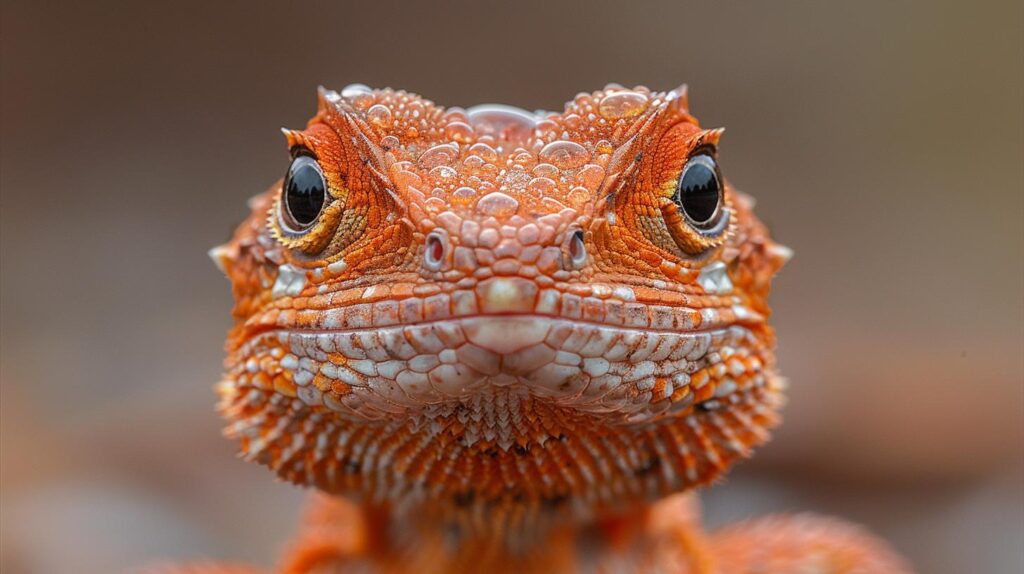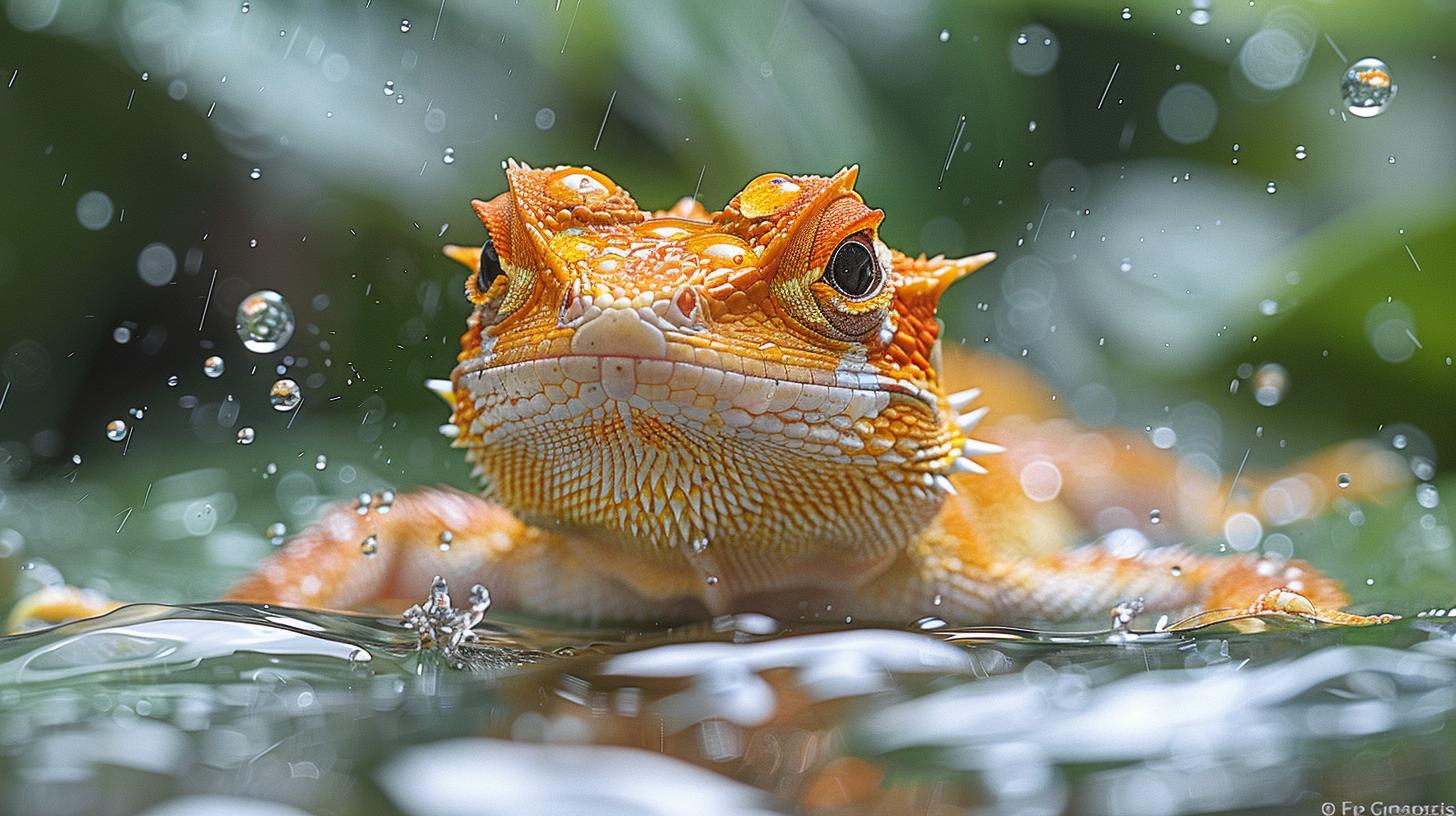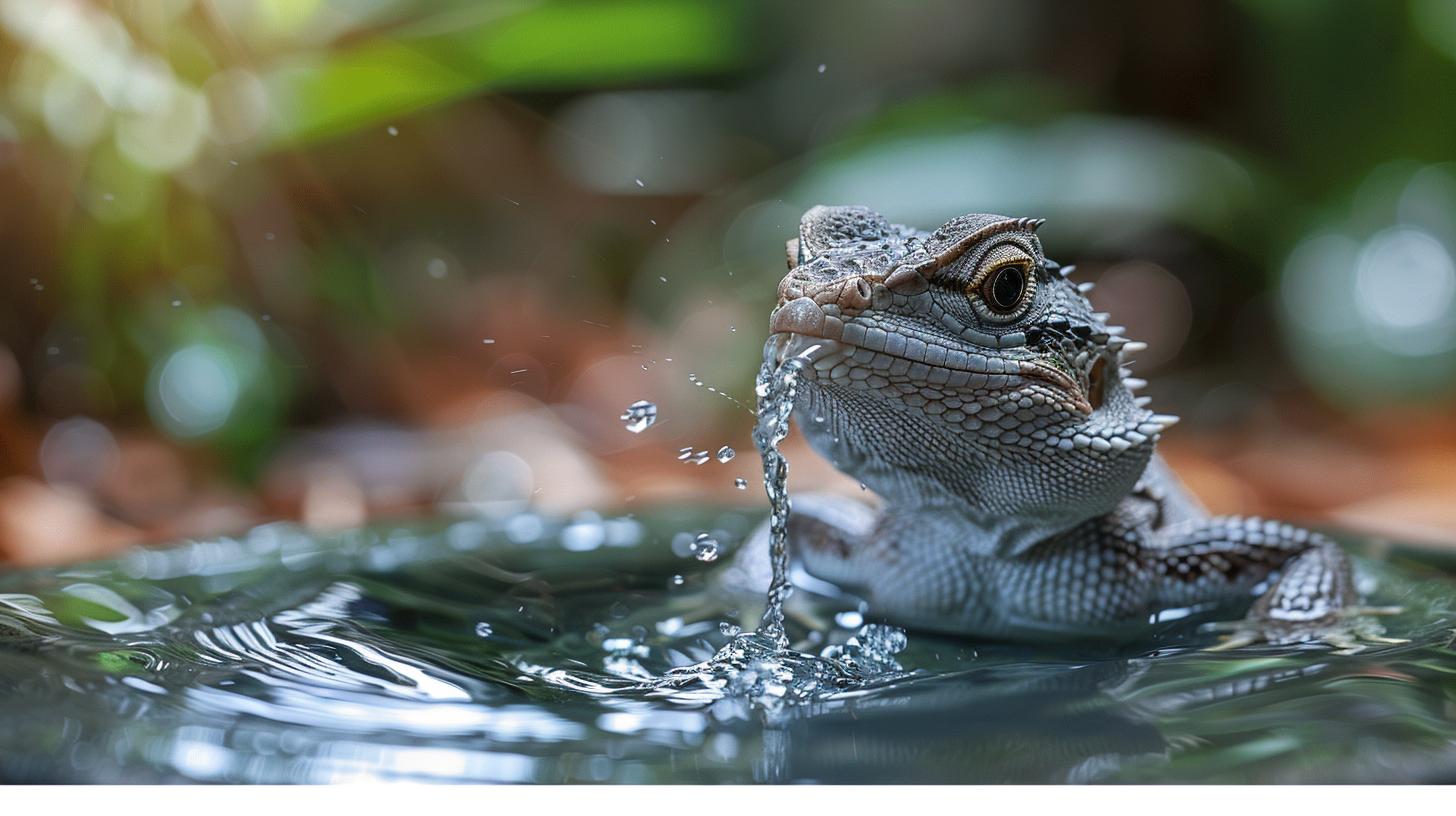Vet-Approved Strategies to Keep Your Lizard Hydrated

- Understanding Your Lizard's Hydration Needs
- The Role of Environment in Lizard Hydration
- Water Bowl Basics
- Lizard Hydration Strategies Beyond Drinking Water
- Recognizing and Responding to Signs of Dehydration
- Preventative Measures to Avoid Dehydration
- Ensuring Long-Term Hydration Health
- Frequently Asked Questions
Understanding Your Lizard's Hydration Needs
In the intricate dance of pet care, attention to lizard hydration strategies emerges as a foundational step for ensuring the health and happiness of your scaly companion. The quest for understanding how best to quench their unique thirst begins with recognizing why hydration is pivotal in the realm of reptile welfare.
With guidance harvested from seasoned veterinarians, this exploration reveals the critical role water plays in a lizard's life, shedding light on signs of dehydration and how factors such as age, size, and species intricacies paint a diverse picture of their needs.
Diving deeper into the scales of knowledge, we uncover that not all lizards drink alike-some prefer catching droplets from leaves or absorbing moisture through their skin rather than sipping from a pool. Such insights necessitate a closer look at the role of environment in promoting desirable hydrating habits.
Truth be told, creating an ambiance that mirrors their natural habitat can profoundly affect their drinking behavior. This segment demystifies how temperature fluctuations and humidity levels within their enclosures serve as invisible yet potent conductors guiding their hydration rhythm.
The humble water bowl, often overlooked yet essential, undergoes scrutiny in our discussion on Water Bowl Basics: Size, Placement, and Maintenance. It's not merely about providing water; it's about making it accessible and appealing to your cold-blooded pals.
Best practices emerge focusing on selecting bowls that invite your lizard to indulge in hydration while emphasizing the paramount importance of cleanliness to stave off potential health adversaries lurking in stagnant waters. Engaging with these foundational aspects sparks a broader conversation on alternative measures beyond conventional drinking methods-one that introduces innovative approaches designed to replicate a much more naturalistic approach to meeting your lizard's hydration requirements.
The Role of Environment in Lizard Hydration
In understanding the critical role that the environment plays in keeping your lizard adequately hydrated, it's essential to grasp the concept of how these ectothermic creatures interact with their surroundings. The thermal and humidity levels within a lizard's habitat can significantly affect its hydration status.
For instance, an environment that is too dry may accelerate dehydration as the lizard loses more water via respiration and evaporation from its skin. On the other hand, an overly humid setting might discourage a lizard from drinking adequately due to a reduced sense of thirst.
Ensuring optimal humidity levels within your pet's terrarium is therefore a cornerstone among effective *lizard hydration strategies*. This involves using hygrometers to regularly monitor humidity and employing methods such as misting systems or humidifiers to adjust moisture levels accordingly.
Additionally, maintaining an appropriate temperature gradient in the habitat encourages your lizard to regulate its body temperature through behavioral thermoregulation without losing excessive moisture. Temperature management can be achieved by strategically placing heating lamps or pads at one end of the enclosure, thus creating a thermal gradient that allows your lizard to move between warmer and cooler areas as needed.
Another vital aspect of creating a hydration-friendly environment is providing features that mimic a natural ecosystem, such as live plants, which can increase humidity levels naturally and offer shaded areas for the lizard to cool down. Incorporating a shallow water bowl or even a small waterfall feature can not only meet their drinking needs but also contribute to ambient moisture. Regular cleaning and maintenance of these water sources ensure they remain appealing and safe for your pet.
| Strategy | Benefit |
|---|---|
| Misting Systems / Humidifiers | Keeps consistent humidity levels |
| Heating Lamps / Pads with Thermal Gradient | Allows behavioral thermoregulation without dehydration risk |
| Live Plants & Water Features | Increases natural humidity; encourages drinking behavior |
By carefully considering these environmental factors, you are better positioned to maintain an ideal habitat that promotes hydration through both drinking and absorption via skin or soaking behavior. This approach not only optimizes physical health conditions but also contributes positively to mental well-being by recreating aspects of their natural habitat, encouraging normal behaviors tied to seeking water resources.
Water Bowl Basics
In the realm of lizard hydration strategies, understanding the fundamentals surrounding water bowl basics serves as an integral component. The size, placement, and maintenance of your lizard's water bowl are not only about convenience but also about promoting proper hydration habits, vital for their wellbeing. Let's break down these concepts to ensure your scaly companion stays happily hydrated.
When selecting a water bowl for your lizard, size matters. A common mistake is offering a bowl that is too small or too shallow, limiting access to enough water, especially for larger species.
Conversely, a bowl that's too large might intimidate smaller lizards or even pose a drowning risk. The goal is to provide a bowl that complements your pet's size and type; for instance, *bearded dragons* may prefer wider bowls they can easily climb into whereas *geckos* might need shallower dishes to prevent accidents.
Placement is equally important in encouraging your lizard to drink regularly. Ideally, the water bowl should be placed away from basking areas to keep the water at a cooler temperature but still within a zone that your pet frequents daily. This ensures they don't overlook their chance to hydrate.
Maintenance of the water source cannot be overlooked when discussing lizard hydration strategies. Regular cleaning and fresh refills are mandatory to prevent the growth of bacteria and ensure the health of your pet. Here's a simple outline for keeping their drinking station pristine:
- Daily: Replace water and rinse out any debris.
- Weekly: Deep clean the bowl with mild reptile-safe disinfectant.
- Monthly: Inspect for signs of wear or damage that could harm your lizard.
This routine not only signifies commitment to cleanliness but also habituates checking on various aspects of your lizard's environment and health routinely.
Advancing from this foundation on water bowls deepens our exploration into hydration methodologies without losing sight of their significance within comprehensive care practices for lizards. Leveraging insights on effective lizard hydration strategies including misting systems and dietary adjustments will cater further to diverse needs across species-each thriving on personalized attention toward optimal hydration beyond traditional drinking methods.

Lizard Hydration Strategies Beyond Drinking Water
In the quest to maintain optimal hydration for lizards, pet owners must explore a variety of *lizard hydration strategies* beyond the traditional water bowl. Understanding these alternative methods can significantly contribute to your pet's overall health and well-being.
Misting systems, soaking baths, and incorporating water-rich foods into the diet are among the innovative approaches that deserve attention. Each strategy not only supports daily water intake but also mimics the natural hydration behaviors lizards would exhibit in the wild.
Misting systems represent a technological approach to *lizard hydration*, offering a dual benefit: they increase humidity within the enclosure and encourage natural drinking behaviors. Lizards often lick moisture from their surroundings, including leaves and rocks. A misting system can simulate this environment, making it an excellent tool for species accustomed to higher humidity levels. To implement this strategy effectively:
- Select a misting system designed for reptile habitats.
- Adjust the frequency and duration of misting to match your lizard's specific hydration needs.
- Implement a hygrometer to monitor humidity levels accurately.
Soaking baths are another beneficial practice, particularly for species prone to dehydration or during shedding periods when additional hydration helps facilitate the removal of old skin. A shallow dish with lukewarm water, placed within the habitat once or twice a week, can provide an opportunity for your lizard to submerge themselves.
This method not only aids in hydration but also supports healthy skin and promotes regular bowel movements. It's crucial, however, to always supervise your lizard during bath time to ensure safety.
Integrating water-rich foods into your lizard's diet is an effective way to boost internal hydration. Many fruits and vegetables contain significant amounts of water alongside essential nutrients. Some excellent options include:
These foods should be offered in moderation as part of a balanced diet tailored to your lizard's species-specific nutritional requirements. Consulting with a veterinarian can provide guidance on the best food choices for maintaining proper hydration through diet.
By incorporating these *lizard hydration strategies beyond drinking water*, pet owners can create a more enriching and healthful living environment for their reptilian companions. Not only do these practices promote better hydration habits, but they also enhance the overall habitat infrastructure conducive to thriving lizard health - keeping their scales shiny, spirits high, and bodies well-hydrated without solely relying on traditional water bowls.
As we explore further into maintaining optimum health for our scaly friends, it becomes evident that understanding their individual needs plays a critical role in ensuring long-term well-being. Moving ahead, we will delve deeper into recognizing signs of dehydration early on-a fundamental aspect of proactive reptile care that empowers owners with knowledge-intensive intervention techniques at just the right time.
Recognizing and Responding to Signs of Dehydration
Identifying Dehydration in Lizards
Recognizing the signs of dehydration in lizards is crucial for their health and well-being. As ectothermic creatures, lizards rely heavily on their environment to regulate their body temperature and hydration levels. When these factors are not optimal, dehydration can quickly become a serious issue.
Early symptoms include lethargy, loss of appetite, sunken eyes, and a noticeable decrease in skin elasticity. An easy test for dehydration is the 'skin pinch test': gently pinch the lizard's skin; if it stays tented for a few seconds rather than snapping back promptly, it's likely your pet is dehydrated. Understanding these signs is the first step in responding effectively to this health concern and preventing further complications.
Immediate Steps to Rehydrate Your Pet
Upon noticing any signs of dehydration, immediate action is required to rehydrate your lizard and mitigate any adverse effects on its health. Offering a bowl of fresh water may seem like an obvious first step, but many lizards do not drink standing water actively or realize it's there when they need it most.
Thus incorporating lizard hydration strategies such as misting their skin or introducing a dripping system that simulates raindrops can be more effective in encouraging them to drink.
Furthermore, for severe cases of dehydration, consulting with a veterinarian who might recommend oral rehydration solutions or subcutaneous fluids is essential. This professional guidance ensures that your lizard receives the appropriate care tailored to its specific hydration needs.
Leveraging Hydration Through Dietary Choices
In addition to providing direct sources of water, adjusting your lizard's diet can play a pivotal role in maintaining optimal hydration levels. Incorporating water-rich foods into their diet-such as certain fruits and vegetables recommended for your species of lizard-can significantly enhance their overall water intake without relying solely on drinking water.
It's important to research or consult with a vet about which foods are safe and beneficial for your particular species of lizard since dietary needs can vary widely between different types of lizards. Balancing regular food with these moisture-rich alternatives offers an alternative avenue for keeping your scaly friend well-hydrated and vigorous.
Preventative Measures to Avoid Dehydration
In addressing the critical issue of dehydration in lizards, preventative measures can serve as a lifeline for these exotic pets. Understanding the crucial role that hydration plays in the well-being of lizards is essential for every pet owner. Dehydration in reptiles can lead to serious health problems, including kidney failure, lethargy, and even death.
Therefore, instituting proactive strategies to prevent dehydration is not just beneficial but vital for their survival. By focusing on prevention, lizard owners can ensure their pets enjoy a healthy and fulfilling life.

Acknowledging the myriad factors that contribute to dehydration is the first step toward prevention. These range from environmental conditions within the habitat to inadequate access to water or moisture-rich foods. The interplay between these factors underscores the need for a holistic approach to hydration-one that encompasses not just direct water intake but also considers the overall living conditions and dietary habits of these creatures. Addressing these elements proactively can forestall many common issues related to dehydration.
Optimizing Habitat Humidity
One key aspect of preventing dehydration revolves around optimizing habitat humidity levels. For many lizard species, maintaining a specific range of humidity within their enclosures is crucial for facilitating proper hydration. Through the use of hygrometers-devices that measure humidity-owners can monitor levels accurately and make necessary adjustments.
Employing humidifiers, misting systems, or simply placing bowls of water within the enclosure can help achieve optimal humidity levels. Regularly checking and adjusting this balance ensures that lizards are able to absorb moisture from their surroundings, complementing their direct water intake from drinking sources.
Dietary Measures for Hydration
Beyond environmental management, incorporating lizard hydration strategies into their diet presents another effective avenue for preventing dehydration. Offering a variety of water-rich foods such as fresh fruits and vegetables should become a staple practice among lizard owners.
This not only provides necessary hydration but also adds nutritional diversity to their diet. For some species, such as herbivorous or omnivorous lizards, offering moist foods regularly can significantly boost their total water intake-making it an indispensable strategy in combating dehydration.
Routine Monitoring and Adjustments
Lastly, ongoing observation plays a pivotal role in preventing lizard dehydration effectively. Establishing a routine check-up on your lizard's health status allows owners to identify any signs of potential dehydration early on-facilitating swift intervention before complications arise.
Assessing water bowls daily ensures clean and adequate water supply at all times while monitoring urine excretion can offer insights into their hydration level. With time-sensitive adaptations to both environment and diet based on continuous assessments, preemptive measures against dehydration become deeply integrated into daily care practices-paving the way towards ensuring long-term hydration health for your scaly companion.
Ensuring Long-Term Hydration Health
In wrapping up our discussion on the enduring health of your pet lizard through proper hydration, it becomes clear that understanding and addressing your pet's needs is not just about the immediate effects but also about fostering an environment where they can thrive over time. The journey from recognizing the vital signs of dehydration to implementing vet-approved strategies for hydration requires a dedicated commitment.
Incorporating lizard hydration strategies into the daily care routine plays a significant role in preventing the adverse effects of dehydration, ensuring your lizard maintains optimal health through every stage of its life.
As pet owners, our responsibilities extend beyond basic care; they involve creating a habitat that mirrors their natural environment as closely as possible. This includes managing humidity levels, ensuring clean and accessible water sources, and incorporating water-rich foods into their diet.
By taking these steps, we not only prevent dehydration but also contribute to a holistic approach to our lizards' well-being. Continuous education on the specific needs of your scaly companion will empower you to make informed decisions that enhance their quality of life.
We encourage our readers to engage further with this topic and discover more ways to enrich your pets' lives by browsing through our extensive library of articles. From expert advice on creating stimulating habitats to comprehensive guides on diet and health, our resources are designed to support you in becoming the best pet owner you can be.
Let's embark on this journey together - for more enlightening reads, dive into our collection and uncover all there is to know about nurturing happy, healthy pets.
Frequently Asked Questions
How Do You Hydrate a Lizard?
To hydrate a lizard, offer water in a shallow dish that it can easily access in its enclosure. Additionally, misting the enclosure lightly every day with water provides humidity which lizards absorb through their skin and breathing, assisting in their hydration process. Some species may also benefit from occasional soaking in shallow, lukewarm water to help with hydration and shedding.
How Do You Give Lizards Water?
Lizards can be given water by placing a shallow dish filled with fresh water in their enclosure, ensuring the dish is sturdy to prevent tipping over. Misting their habitat regularly with a spray bottle aids in maintaining necessary humidity levels.
For species less inclined to drink standing water, gently dripping water onto their nose or mouth using a dropper or syringe encourages them to lick the droplets.
How Do You Know if a Lizard Is Dehydrated?
Signs of dehydration in lizards include sunken eyes and dry, wrinkly skin. Lethargy and a decreased appetite are also common indicators. In severe cases, the lizard might have sticky or dry mucous membranes around its mouth. Regularly monitoring these signs will help in assessing the hydration needs of your lizard.
Do Lizards Hydrate Through Their Skin?
Yes, lizards can hydrate through their skin to some extent. They absorb moisture from their surroundings which is why maintaining proper humidity levels in their habitat is important for their overall hydration status. However, they primarily rely on drinking water directly for most of their hydration needs.
How Long Does It Take a Lizard to Recover From Dehydration?
The time it takes for a lizard to recover from dehydration depends on how severely dehydrated they are and how quickly treatment begins. Mild dehydration can be addressed within hours by providing sufficient water and correcting habitat humidity levels, but more severe cases may require several days of careful hydration efforts or even veterinary intervention if fluid therapy is needed.
Can Lizards Drink Pedialyte?
Yes, lizards can drink Pedialyte as an emergency measure for rehydration under certain circumstances as it helps replenish electrolytes lost during dehydration; however, it should not replace regular water intake or veterinary advice.
Always dilute Pedialyte with equal parts of water and use it temporarily until you can consult with a veterinarian for specific recommendations tailored to your lizard's health needs.
Leave a Reply
You must be logged in to post a comment.